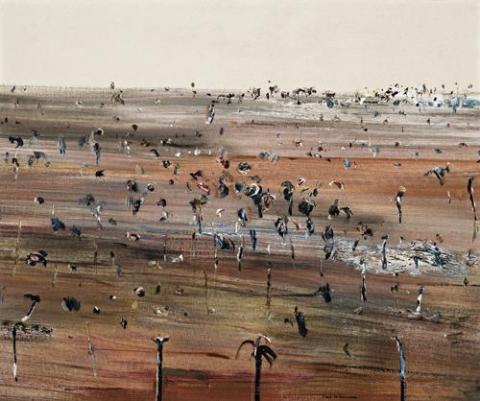SILVER LANDSCAPE, 1968
Fred Williams
oil on canvas
88.5 x 106.5 cm
signed lower right: Fred Williams artist's label attached verso with title, date, medium, dimensions and artist's name
Rudy Komon Gallery, Sydney
Acquired from the above in 1970
Private collection, Queensland
There is a deeply satisfying richness about Fred Williams's paintings of the late sixties arising from their creative maturity, assured technique with numerous references to Lysterfield and the 1968 bushfires that threatened his home at Upwey. The aftermath offered a landscape transformed, strangely beautiful, captured in such 1968 paintings as the Regenerating Ferns with their strangely primordial appeal, and Burnt Landscape, the major version being in the collection of Gordon Darling. While Silver Landscape 1968 has links to the latter painting, it also heralds the masterpiece, Silver and Grey 1969-70 in the collection of the National Gallery of Australia, Canberra. Both Burnt Landscape and Silver Landscape possess the fascinating elixir that changes destruction into regeneration. The horizontally brushed earth, richly dark in one, blends of ochre and silver in the other, is balanced by the vertical accents of the trees, individually gaunt or touched with regrowth. Williams is a classicist of the first order, the canvasses stained and washed with absorbed colour, surfaces enriched by textured crusts and swirls. One refers to the broad expanse of countryside, its vast scale, the other intimate beauty of the Australian bush. Minimalism was in vogue and Williams adjusted his style to suit, presenting the macrocosm through the microcosm.
There are many cross-references in Williams's art- of subjects, mediums and technique. Outstanding in its own right, Silver Landscape is also a key to things that follow. As James Mollison observed, Williams allowed his ideas 'to lie fallow', Silver and Grey 1969-70 being, as Williams said, 'a combination of Lysterfield and the You Yangs, and it's also a combination of my engraving ... etching and aquatints ... .'1 He continued, pointing out that the silver grey comes from the appearance of the zinc plates after many prints have been taken from them. In his paintings, Williams worked over the titanium white base while wet, giving a result like the partially cleared areas of the metal plate.
1. Mollison, J., A Singular Vision: The Art of Fred Williams, Australian National Gallery, Canberra,1989, pp.137 & 143
DAVID THOMAS
